Pros
Cons
Physical Tour
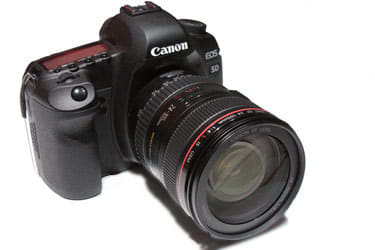
Front
The front of the 50D is dominated by the lens mount, which is an EF style that's compatible with most Canon mount lenses, including the cheaper EF-S ones used on many low-end SLRs such as the Digital Rebel. Other features of note include the pop-up flash that's hidden under the Canon logo, the lens release button to the right of the lens mount, the shutter button on the top left and the AF illuminator to the shutter's right.
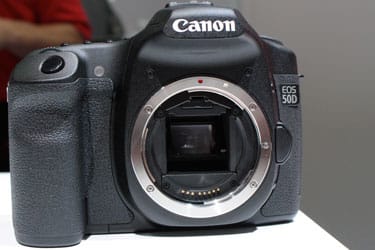
The front of the D50 is mostly dominated by the lens mount**
**
Back
The back of the D50 is where the real action is. The main feature that leaps out and grabs you is the screen: a big 3-inch LCD with an impressive 920,000 pixels. That provides a very sharp image, which is excellent for checking the focus during playback or when shooting in Live View mode. Around the screen are the controls; underneath are buttons for going into playback mode, for deleting images, for putting info up on the screen, for setting the picture mode and accessing other functions. Next to these buttons is the on/off switch, which also acts to enable or disable the scroll wheel above it. In the middle of this scroll wheel is the set button, which selects menu options. Above this is the 4-way joystick control, which is used for navigating around the menu structure.
Above the screen are more buttons; the menu button and the Live View button. Next is the viewfinder. Finally, on the top left of the back are a group three buttons; one for enabling the AF in Live View mode and two for zooming in and out in the playback mode. When shooting, these buttons also double as the focus point selector and the exposure lock. All three are within easy reach of the thumb when holding the camera in one hand, making for easy control of these features when shooting.
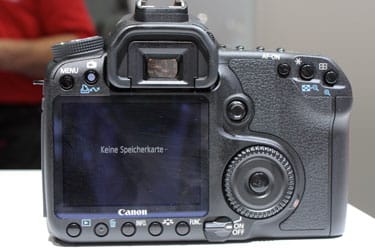
The back of the D50 is a busy place, with a 3-inch LCD
screen and lots of buttons
Sides*
*The left side is a hotbed of activity, as it is home to all of the ports and sockets on the camera. These are located under two rubber covers that should do a decent job of protecting them from the slings and arrows of outrageous fortune; they seem to make a good seal against dirt and dust. Under the first cover are the power and remote control ports, while the second one covers the USB ports, video out port and the mini HDMI port.

On the left side, the ports are located under
two rubber covers

*The right side of the 50D claims the honor of
hosting the memory card slot*
Top
The top of the 50D has a good number of controls, although not as many as the more complicated 5D Mark II. Looking from left to right, we have the scene mode dial, the flash hot shoe and a number of buttons above the secondary display. These buttons control (from left to right) the backlight of the secondary display, the metering and white balance, the AF mode and drive mode, and the ISO and exposure compensation. These double up because of the dual controls; the first function is accessed with the control wheel next to the shutter, and the second function with the scroll wheel on the back of the camera body. The secondary display is an LED screen, rather like an old calculator, but it contains a lot of information, such as the shooting mode, drive mode, ISO, settings while shooting, etc.
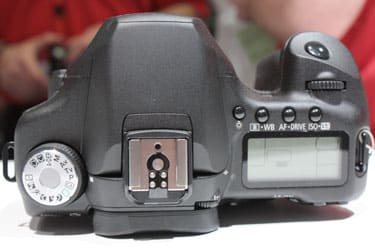
The top of the 50D positions a lot of function dials and buttons in one place
The bottom of the 50D is not a hugely exciting place, unless you happen to be a tripod. If you are, this is where you connect to the camera, through the tripod socket in the center of the camera base. On the right is the cover for the battery cavity.
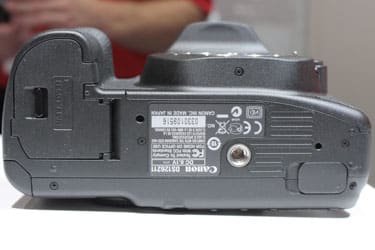
*The bottom of the 50D is home to the tripod socket and
the battery compartment
*
Components
Viewfinder
Canon claims that the viewfinder for the 50D provides about 95% coverage, which seems about right; the captured images definitely did not have the same edges as the viewfinder image. This is a little annoying and makes composing shots rather awkward, as you can't line up objects against the edge without taking a shot and looking at on the LCD screen to see if you got it right. Otherwise the viewfinder is fine; images looked clear and bright and there is a good selection of information presented along the bottom of the frame that tells you the current settings, including the shutter speed, aperture, ISO setting, etc.
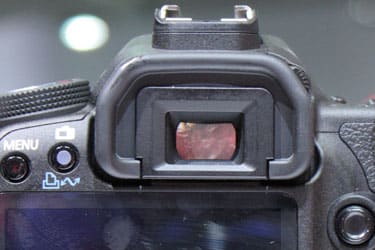
The viewfinder on the 50D has only 95% coverage, meaning
that your photos don't turn out exactly like what you see
LCD Screen
The big, bright 3-inch LCD screen is definitely a huge improvement over the 40D. Although it is the same size, it is definitely much clearer and brighter, because the screen resolution has jumped substantially, from 230,000 pixels on the 40D to 920,000 pixels on the 50D. This makes the images on screen seem much sharper and brighter.
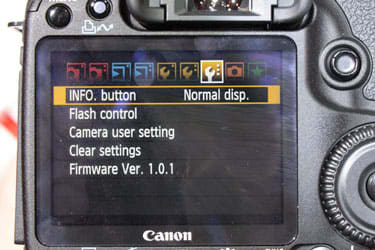
The LCD screen of the 50D is the same size as
its predecessor, but boasts much higher resolution
**
Flash
Some higher-end SLRs skip the built-in flash, but the 50D has one built in above the lens mount. The flash pops out when you press the dedicated button. It doesn't travel particularly far, though, so red -eye may be an issue. Fortunately, the camera includes red-eye correction in the form of a number of pre-flashes which make the iris close. The guide number for this flash is 13, unchanged from the 40D, which should be good for about 13 feet of coverage.
**
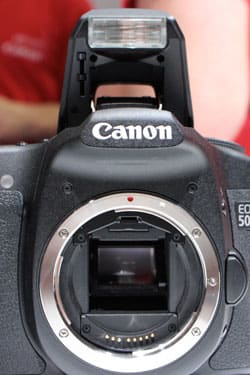
The relatively high flash position helps minimize red-eye.
**Lens Mount**
The 50D has a standard Canon EF lens mount, which will work with both EF and the EF-S lenses that are used on the lower-end Canon SLRs. But if you use EF lenses on the 50D, you will get a smaller angle of view from what you are used to with a 35mm film camera because of the smaller sensor size (this is also often referred to as the crop factor). While this is great for telephoto lenses (as you get a free 1.6 x boost), it’s not so great for wide angle lenses, as the field of view will be reduced. Canon’s EF-S series and L series professional lenses are built with this in mind, though. UPDATE: this section of the review was updated to clarify the explanation of the crop factor).
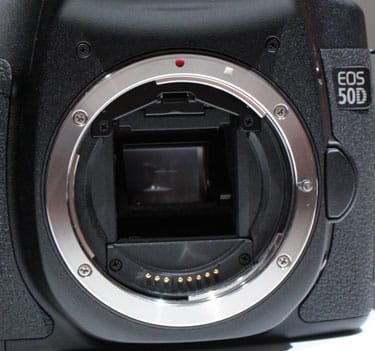
The EF lens mount can work with both EF and EF-S lenses
Connections
The 50D has a decent set of connections, which should cover most eventualities. There's a power port (which allows you to charge the battery inside the camera), a remote control port (which allows for wireless remote controls), a USB port and two video outputs: an analog video and a mini HDMI port for connecting to a HDTV.
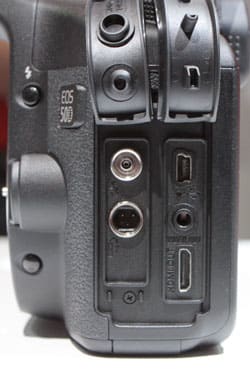
A wide selection of ports provide everything from fast
computer connections to viewing on a HDTV
Battery
The battery of the 50D fits into the hand grip from the bottom. On some cameras, access to the cover for the battery port is blocked by the tripod if the camera is mounted, but that's not the case on the 50D, as the battery cavity is well away from the tripod socket. The battery itself is a 1380mAh model, which is significantly less than the 1800mAh of the 5D Mark II battery. If this translates into a lower battery life remains to be seen, but we'll be looking into this as part of our full review that will be coming soon.
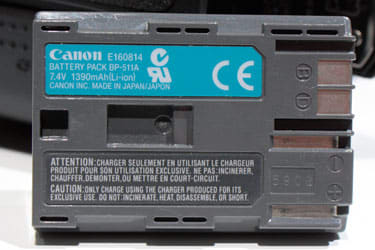
The battery of the 50D hold 1380mAh of charge
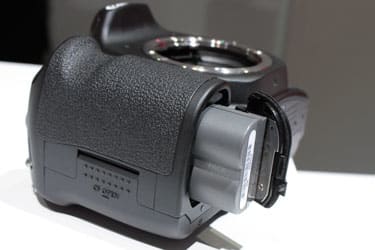
The battery fits neatly into the camera's hand grip**Memory**
The 50D uses CompactFlash cards to store images, skipping the SDHC cards that are becoming increasingly common. This will be welcomed by anyone who has a stockpile of CompactFlash cards. The door that covers the slot opened very easily, and swapping the cards out should not take long.
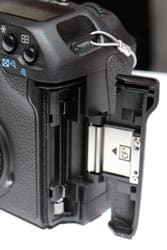
The 50D uses CompactFlash memory cards
Other Features
*Dust Removal and Mapping *– The 50D includes an ultrasonic dust removal system, which uses an ultrasonic vibration to try and knock dust off the sensor. If that doesn't work, the system can map the dust and remove it using Canon's own software. It does this by asking you to take a picture of a white object, then working out which dark specks are dust on the sensor. However, this only happens in the software after the images are downloaded, and it only works with Canon's own image editing software.
Design / Layout
Model Design / Appearance
Like all of the EOS SLRs, the 50D is functional rather than aesthetically pleasing. Not that it's an ugly camera; it's just not going to win any beauty contests. Fortunately, it delivers where it counts; we found that the body fits well in the hand, with the buttons falling right under the fingers and a wide, comfortable grip that makes it a pleasure to hold and use.
Size and Handling
The 50D falls in the middle of the size and weight range for Canon SLRs; it is smaller than the 5D Mark II, but somewhat larger than the Digital Rebels. It measures 5.7 x 4.2 x 2.9 inches (145 x 107 x 74mm) for the body only; the size of the lens depends on which one you choose, of course. It's also no lightweight, with a body that weighs in at about 26 ounces (737g), plus the lens that can add a considerable amount to that. But the relatively large size and weight of the camera does not seem to translate into problems; we found in our hands-on tests at the Photokina show in Cologne that the camera fits well in the hand, and that the buttons fall under the fingers easily, both on the front and back of the camera. On the back, the thumb rests over the buttons for exposure lock and changing the focus point, and on the front the index finger falls on the shuttle, but can also easily reach the control wheel and the other buttons above the secondary display.
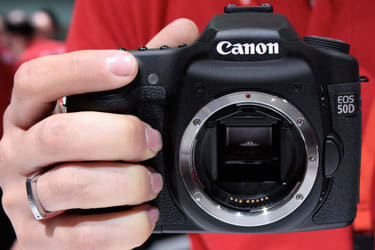
*

-
The 50D feels comfortable in the hand
Menu
The 50D uses the standard Canon menu structure, where the menus are divided up into a number of different categories, indicated by icons at the top of the screen. You navigate through the menus using the joystick control, and select options by using the scroll wheel and the set key. The overall design works well; navigating the menus is relatively straightforward and it is not difficult to find what you need. However, the choice of what appears in what menu is rather odd; the first options to appear when you press the menu button include things like setting whether or not the camera can take photos without a memory card being installed. We'd rather see more frequently used options (such as image resolution or white balance settings) included on this first page.
*

**

**

**

**

**

**

*

*

*
**Ease of Use
Overall, we found the 50D very easy to use. Although it is a complicated camera, it is laid out in a logical way, and the menu makes it easy to find options.
Modes
Auto Mode
Turn the mode dial to the green rectangle, and the camera turns into a point-and-shoot with all of the options controlled by the silicon brain of the camera itself. We weren't able to test photos taken in this mode at the Photokina show, but we have generally found that Canon cameras do a good job of choosing the right settings in auto mode. Those who prefer to make some of their own choices will prefer the program mode, where the camera still makes the choices, but the user can control aspects such as the ISO setting, focus mode and point, etc. **
**
Movie Mode
Unlike the 5D Mark II, there is no movie mode on the 50D. However, the 50D does have both an analog and an HDMI video output, so you can look at photos on an standard definition or high definition TV.
Drive / Burst Mode
Thanks to the newer and faster Digic 4 processor in the 50D, Canon claims it can shoot at up to 6 frames a second. We weren't able to do our usual timing test on this, but it certainly seemed to be a speedy camera, so we would anticipate that the 50D would live up to Canon's promises. Canon also claims that the 50D can capture a burst of 60 JPEG and 16 RAW images, which would mean about 10 seconds of capture at 6 frames a second. Again, we were unable to verify the veracity of this claim, but it sounds plausible. We'll know more when we get the camera into our lab to review. However, it is worth noting that this is actually a slight reduction from the earlier 40D, shot at 6.5fps, so the extra resolution comes at a slight cost. This should not be a big issue for most users, though; 6fps is more than enough for general use.
Playback Mode
The 50D playback mode is straightforward, but has the features most users are likely to need. You can view up to 9 images on the screen, and we found that we could quickly zoom in and out, both looking at multiple images and zooming in on a single shot to check the fine details. The two buttons on the back right corner of the camera allow you to zoom in up to 10x; enough to check focus on an image. All of the usual features are also present for examining the metadata saved with your images; you can look at histograms of luminance for white and RGB, check the settings at which the photo was shot, etc.
Custom Image Presets
The 50D offers a number of scene modes for shooting, all of which are available on the mode dial. Canon calls these 'programmed image control modes,' but the effect is the same; they set the camera up appropriately to take photos in a particular situation. The available modes are portrait, landscape, close-up, sports, night portrait and flash off. A mode called Creative Auto (CA on the dial) is also available, which puts the shutter and aperture on automatic, but allows the user to tweak settings such as color and sharpness.
Control Options
Manual Control Options
A wide selection of manual controls are available on the 50D, including a full manual mode, plus shutter and aperture priority modes.
Focus
The 50D has a 9-spot auto focus system which we found to work well in our limited tests at the Photokina show. It quickly found the right focus point and drove the lens to it. Four auto focus modes are available: Auto, One-Shot AF (which focuses when you press the shutter halfway down), Predictive AI Servo AF (which tries to continuously refocus based on the movement in the image) and AI Focus AF (which uses the camera's smarts to figure out when to refocus). There is also a manual focus mode that disengages the motor and lets you focus by hand. The focus point is determined by pressing down the focus point button and rotating the control dial, which is a bit of a hassle; it can take quite a long time to cycle through all of the points.
ISO
The ISO range starts at 100, then goes up to 6400 in the automatic mode. However, this can be extended to 12800 if the ISO extension custom function is enabled. We weren't able to test the noise at these high settings.
White Balance
Six white balance presets are available, covering the usual options: Daylight, Shade, Cloudy, Tungsten Light, White Fluorescent Light and Flash. A full auto mode is also available, as well as a custom mode and a color temperature mode, where you enter the value directly. Missing are the more advanced customization tools present on the 5D Mark II; you can't tweak the individual color axes. However, most users won't miss these, as they are only useful to those who need very precise control over how colors are captured.
Metering
Four metering modes are available on the 50D; evaluative (which measures 35 zones in the image and then makes a judgment based on a formula buried deep in its silicon brain), partial (which uses an 8 percent area at the center of the image), spot (using a 3.5 percent area) and center-weighted average. That's a pretty standard assortment, which should be enough for most users. Some users (such as those who shoot in difficult situations) may look for a smaller spot mode, but 3.5 percent is fine for most.
Shutter Speed
The 50D has a very impressive shutter speed range; the shortest is 1/8000 of a second and the longest is 30 seconds, plus bulb mode for holding exposures as long as you like. The standard flash sync speed is 1/60 of a second, but that can be sped up to 1/250 second with one of Canon's own flash guns, a useful feature for outdoor fill flash. Two self-timer modes are available; 10 seconds and 2 seconds. UPDATE: an earlier version of this review incorrectly listed the maximum flash synch speed as 1/200 of a second.
Aperture
The 50D has the standard connections that allows it to work with all compatible lenses, including the EF-S lenses supplied with some cameras.
**Image Stabilization
**No image stabilization is provided in the camera body itself. An increasing number of Canon lenses now include optical image stabilization, where an element of the lens moves to correct for small movements, but some inexpensive lenses and many older models lack this feature. Other camera manufacturers employ sensor stabilization (where the sensor can move to compensate for the hand movements) within the camera body. This effectively adds image stabilization to any lens mounted on the body, and enables cheaper lens construction without sacrificing the stabilization feature. Thus far Canon has chosen not to take this route.
Picture Quality / Size Options
The 50D offers a good selection of picture quality and size options. There are two image quality choices when shooting JPEGs; fine and normal. The biggest picture size is 4752 by 3168 pixels, where the fine quality JPEGs will be about 5 megabytes. Shooting in RAW mode, the same size photos will be about 21 megabytes. The smallest picture size available is 2352 by 1538 pixels, which would be about 0.9 megabytes in size.
Picture Effects Mode
There are no picture modes on the 50D, but it does offer something similar in the Picture Style controls, which allow users to tweak controls for color and sharpness. Nine picture style modes are available, including the presets of Standard, Portrait, Landscape, Neutral, Faithful, Monochrome and three user-defined settings.
Conclusion
**
Conclusion**

Our initial impressions of the 50D are positive; it looks to be a solid upgrade to a good camera, adding extra resolution. But there is no real speed increase over its predecessor; it shoots at 6 frames per second, while the 40D was slightly faster at 6.5fps. And it is lacking the hot feature that most other SLRs seem to be adding at present: video recording. Whether that is a problem depends on what kind of user you are. If you already have a camcorder, you likely won't miss it.
The other changes also seem to be positive. The 50D is as responsive and easy to use as the 40D, and has a slightly improved viewfinder that shows more of the photo area. Sports shooters and those with small children will like that it keeps the speed up high with 6 frames per second capture, and the camera seems to be able to keep this up for a an extended time. However, there are other cameras available that can beat this by a considerable margin; the Casio Exilim EX-FH20 can capture 40 frames a second, for instance.
Fundamentally, the 50D looks to be a welcome update to the 40D, but unless you have a burning desire for the extra resolution, we wouldn't recommend that 40D users upgrade. The 50D is definitely a solid pick for a serious shooter who lacks the budget for higher-end models like the 5D Mark II and the Nikon D300, but wants a solid, dependable SLR that can handle rough treatment.
Specs / Ratings
**Specs Table
**{{manufacturer_specs_table}}{{raw_scores_table}}
Meet the tester
Richard Baguley is a veteran writer who has written about technology ranging from Alphabet to Zip file utilities. He has contributed to pretty much every major tech publication, including Amiga Format Magazine, PC World, Wired, CNET, Toms Guide, Forbes, and many others. He lives in the Boston metro area with his wife, dog, and an indeterminate number of cats.
Checking our work.
Our team is here to help you buy the best stuff and love what you own. Our writers, editors, and experts obsess over the products we cover to make sure you're confident and satisfied. Have a different opinion about something we recommend? Email us and we'll compare notes.
Shoot us an email